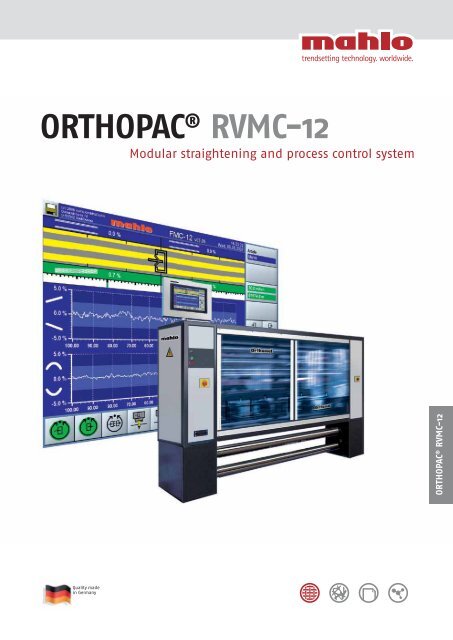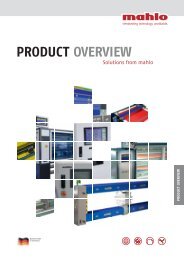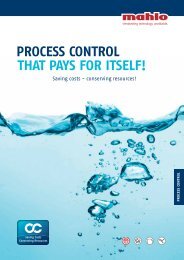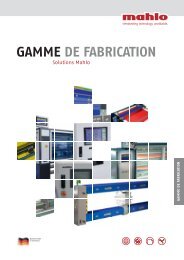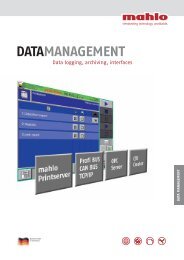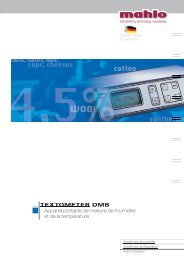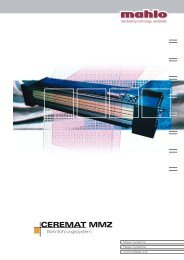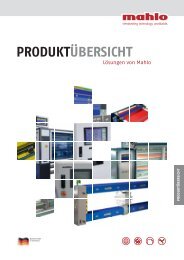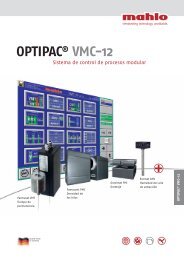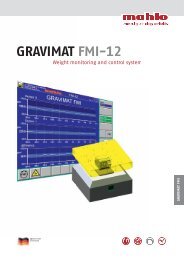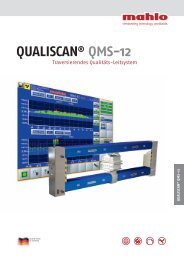Orthopac RVMC-12 - Mahlo GmbH
Orthopac RVMC-12 - Mahlo GmbH
Orthopac RVMC-12 - Mahlo GmbH
Create successful ePaper yourself
Turn your PDF publications into a flip-book with our unique Google optimized e-Paper software.
ORTHOPAC ® <strong>RVMC</strong>-<strong>12</strong><br />
Modular straightening and process control system<br />
Quality made<br />
in Germany<br />
ORTHOPAC ® <strong>RVMC</strong>-<strong>12</strong>
MODULAR STRAIGHTENING AND<br />
PROCESS CONTROL SYSTEM<br />
ORTHOPAC ® <strong>RVMC</strong>-<strong>12</strong><br />
2 <strong>Orthopac</strong> ® <strong>RVMC</strong>-<strong>12</strong><br />
TEXTILE<br />
A modular system for both fully automatic correction of bow and skew and process control<br />
Menu selection on an <strong>Orthopac</strong> <strong>RVMC</strong>-<strong>12</strong><br />
User-interface for an <strong>Orthopac</strong> <strong>RVMC</strong><br />
straightening system<br />
Applications<br />
Product-highlights<br />
✓ Modular system architecture<br />
✓ Easy to retrofit<br />
✓ User-friendly<br />
✓ Informative process visualisation<br />
NONWOVEN PAPER PLASTIC<br />
Cost-effective and quality-conscious textile finishing is primarily<br />
an operational issue; more often enough, however, it<br />
determines quite simply the extent of market participation.<br />
Globalisation of the markets allows production capacity to<br />
flourish wherever standards in terms of price and/or quality<br />
can best be met. In addition, there is often the need for<br />
a greater degree of flexibility in long-term planning and<br />
product lines. To help quality conscious finishers, <strong>Mahlo</strong> ®<br />
turned the idea of combining essential process parameters<br />
into a modular concept. The <strong>Orthopac</strong> <strong>RVMC</strong> is just such a<br />
modular process control system for use on stenters. Given that<br />
there was already a latent need for monitoring various process<br />
variables, it made sense to integrate multiple devices into an<br />
overall concept. This results overall in higher financial returns than<br />
by adding individual pieces of equipment. And even with a limited<br />
investment budget, it give finishers a chance to respond to technical<br />
progress and meet increasing demands from the market. Additional<br />
options are available at any time for expanding the system to meet<br />
individual requirements.<br />
Fundamentals<br />
An <strong>Orthopac</strong> <strong>RVMC</strong> combines the functions of an <strong>RVMC</strong> straightening<br />
unit with those of the Optipac VMC process control system in one<br />
package! It takes advantage of the savings potential resulting from<br />
alternative and/or parallel use of common components. The software<br />
packages for <strong>Orthopac</strong> FMC and Optipac VMC remain self-contained.<br />
The basic construction of the modular concept uses essentially the<br />
<strong>Orthopac</strong> straightening machine as a basis.
In addition to the intelligent bow and skew detection facility already<br />
integrated into the straightening machine, further intelligent sensors<br />
can be connected to the processing electronics in the end panel<br />
of the straightening machine via a CAN bus link. The existing 15"<br />
touchscreen on the straightener is used for visualising the measurement-related<br />
data. A switching option allows the user to bring the<br />
application of interest to the foreground and indicate any existing<br />
alarm condition in the background application. Easy to customise,<br />
combined displays of measured values enable machine personnel to<br />
monitor the entire process with the greatest of ease.<br />
In an optional expansion stage a second 10.4" TFT display and control<br />
terminal in the end panel of the straightener can permanently display<br />
one or the other application simultaneously and enable it to be<br />
operated.<br />
Specifically, on a stenter the following parameters can be measured,<br />
visualised, controlled within the limits of the stenter‘s manipulated<br />
variables, and documented using special software packages<br />
(print server):<br />
- Weft and course bow and skew / bow and skew rollers<br />
on an <strong>Orthopac</strong> <strong>RVMC</strong><br />
- Liquor pickup / squeezing (nip) pressure<br />
- Pick and course count / overfeed<br />
- Exhaust humidity / exhaust fan speed / damper opening<br />
- Fabric temperature / line-speed and dwell time<br />
- Weight per unit area / overfeed<br />
- Residual moisture / line-speed<br />
- Stretch and shrinkage / overfeed<br />
- Product width<br />
Customer benefits<br />
✓ Online monitoring and control of all relevant parameters<br />
✓ Increased productivity<br />
✓ Optimised manufacturing reliability<br />
✓ Optimised process repeatability<br />
✓ Documentation of quality<br />
✓ Provides a comparative basis for quality standard<br />
✓ Considerable energy savings<br />
✓ Short payback times<br />
CONTENTS<br />
BASIS<br />
ORTHOPAC ® FMC 4<br />
Bow and skew detection – simply unique<br />
Visualization 6<br />
Particularly intuitive<br />
MECHANICAL<br />
<strong>RVMC</strong> straightener 8<br />
The standard<br />
MFRC/DFRC straightener 10<br />
For fine-tune straightening<br />
G<strong>RVMC</strong> straightener <strong>12</strong><br />
The reinforcer<br />
X<strong>RVMC</strong> straightener 14<br />
Especially precise<br />
Combi-systems 16<br />
Tailor-made solutions<br />
Options 18<br />
For every application<br />
PROCESS CONTROL<br />
Sensors 20<br />
Measuring, logging, controlling<br />
TECHNICAL DATA<br />
All technical data from page 23<br />
<strong>Orthopac</strong> ® <strong>RVMC</strong>-<strong>12</strong><br />
3
TEXTILE<br />
NONWOVEN PAPER PLASTIC<br />
Product-highlights<br />
✓ Optimized optics ensure<br />
maximum possible resolution<br />
of the angle of distortion<br />
✓ Direct, instantaneous signal<br />
processing determines the<br />
angle in a trice<br />
✓ Optimized back and<br />
incident lighting<br />
✓ Integrated pick or knitted-<br />
course counter<br />
✓ No product-specific<br />
adjustment required<br />
✓ High-speed scanning<br />
✓ Product change detection<br />
✓ Integrated recipe manage<br />
ment facility<br />
✓ Double-sided scanner;<br />
enables face and reverse<br />
side scanning<br />
Customer benefits<br />
✓ Broadest scanning spectrum<br />
on the market<br />
✓ Simple, intuitive operation<br />
✓ Automatic scanning even<br />
of the most complex product<br />
structures<br />
✓ No residual distortion<br />
✓ Performs optimally in rel-<br />
tion to its very modest<br />
physical dimensions<br />
4 <strong>Orthopac</strong> ® <strong>RVMC</strong>-<strong>12</strong><br />
BASIS<br />
ORTHOPAC FMC<br />
BOW AND SKEW DETECTION – SIMPLY UNIQUE<br />
Applications<br />
Skewing of the product during manufacture<br />
alters the structure of textile webs. A distorted<br />
product depreciates in useful value,<br />
affects subsequent processing and invites<br />
complaints. An <strong>Orthopac</strong> detects and eliminates<br />
product bow and skew, and in doing so its optical<br />
sensing system is not deterred by either the variety of<br />
colours, printed or Jacquard patterns or surface textures such<br />
as pile and loop usually encountered in textiles. The <strong>Orthopac</strong> detects<br />
and analyses the regular basic structure of the product – weft, course<br />
or rows of tufting – and if required also indicates their density.<br />
The <strong>Orthopac</strong> FMC-<strong>12</strong> is an all-purpose system for automatic control of<br />
various straighteners, draw-rollers, and differentially or multi-motor<br />
driven stenter chains, and can be installed at the feed and delivery<br />
end of a stenter. It features a digital scanning system and microprocessor<br />
which adapts automatically to a wide variety of fabrics, and a<br />
screen display of the distortions.<br />
Principle of operation<br />
A number of scanners and lamps are spaced evenly across the product<br />
web. The cloth runs between the sensors and lamps. The structure of<br />
the passing weft and courses modulates the light intensity measured<br />
by the scanners. The repetitive nature of the passing picks or courses<br />
create a regular light-dark pattern. This in turn generates a modulated<br />
signal in the scanner’s receiver system. A centrally-pivoted,<br />
cylindrical lens in the scanner oscillates to a specific angle in relation<br />
to the passing picks. When the lens is parallel with the pick or course,<br />
signal modulation is at its maximum. It then decreases as the oscillating<br />
lens progressively cuts across the weft line. Unwanted signals<br />
that differ from the frequency of the picks, knitted courses or rows<br />
of tufts are filtered out digitally, so that the system can analyse the<br />
pure bow and skew-related signals and, from those, automatically<br />
compute the weft or course configuration.<br />
By using a lamp with infrared LEDs, the light shining onto each scanner<br />
can be controlled automatically and individually. The new lamps<br />
have a much longer working life, and consume far less energy than<br />
conventional ones, two further attributes of the new technology.<br />
If certain materials barely allow light to shine through them, or their<br />
surface texture has distinguishable characteristics, better results can<br />
be obtained by using reflected rather than back light.
The scanners therefore feature a built-in infrared light source with<br />
automatic intensity control, which can be switched on in place of the<br />
back- lighting lamps.<br />
The optoelectronic method of measurement can be<br />
optionally extended to include hybrid scanning. The<br />
practical experience gained in the area of image<br />
processing has been used to create the most innovative<br />
and world‘s best system for detection of distortions.<br />
By combining both systems, and through use of existing synergies<br />
and potentials, the <strong>Mahlo</strong> ® scanning technology has taken yet another<br />
step further towards perfection.<br />
The highlight of the hybrid scanning system is fully automatic weft<br />
or course detection along with recipe changing using SOS technology<br />
(Self-Optimizing System). The new, innovative Hybrid Scanning ® with<br />
revolutionary double-sided scanners is a sensing system with the widest<br />
dynamic range and broadest scanning spectrum on the market.<br />
The scanners on an <strong>Orthopac</strong> need to check for distorted weft directly<br />
behind the straightening device, so that they can determine the out-<br />
come of the straightening process as fast as possible.<br />
The industrial PC communicates via microcontroller with the scanners<br />
and roller adjustment mechanism. It can be networked with a host<br />
computer and can print out a record of the progressive weft-line<br />
trend for quality documentation. The use of Ethernet technology<br />
also results in a considerable reduction in cabling expenditure. The<br />
<strong>Mahlo</strong> ® –Service department can be contacted via modem.<br />
Scanners (here with the hybrid system)<br />
in action<br />
TK-<strong>12</strong> scanner:<br />
Distortion detection with back or incident light<br />
Sectional diagram of a system with<br />
hybrid scanning<br />
<strong>Orthopac</strong> ® <strong>RVMC</strong>-<strong>12</strong><br />
5<br />
ORTHOPAC FMC
TEXTILE<br />
NONWOVEN PAPER PLASTIC<br />
Product-highlights<br />
✓ Precise, instructive and<br />
progressive display of<br />
any bow and skew<br />
✓ Menu-controlled service<br />
settings<br />
✓ Two-part combi-image monitoring<br />
simultaneously<br />
2 scanner assemblies<br />
✓ Variable percentage of preset<br />
bias (left: skew, right: bow)<br />
✓ Direction of product fl ow and<br />
momentary lie of the weft<br />
✓ Momentary distortion in<br />
percent (left: skew,<br />
right: bow)<br />
✓ Freely scalable histograms<br />
(above: skew, below: bow)<br />
✓ Variable scaling for histogram<br />
mapping, e.g. -<br />
5...0...+5 (above: skew,<br />
below: bow)<br />
✓ Password protection - unauthorised<br />
users are denied<br />
access to the program<br />
✓ Recipe management<br />
✓ Integrated audio response<br />
Customer benefi ts<br />
✓ Menu guide in all<br />
common languages<br />
✓ Extremely user-friendly<br />
✓ Ergonomic user prompting<br />
✓ Easy to operate<br />
6 <strong>Orthopac</strong> ® <strong>RVMC</strong>-<strong>12</strong><br />
BASIS<br />
VISUALISATION<br />
EVERYTHING AT A GLANCE<br />
1<br />
2<br />
5<br />
<strong>Orthopac</strong> simulation with active and inactive elements<br />
Display of values from various process control sensors<br />
4<br />
3<br />
The user interface<br />
consists of fi ve areas:<br />
1. Title line:<br />
General information<br />
(including alarm bar)<br />
2. Display area:<br />
Selectable screen pages<br />
(display forms)<br />
3. Selection block:<br />
Navigation within the<br />
program<br />
4. Vertical block:<br />
Touchpads for main<br />
options<br />
5. Horizontal block:<br />
Touchpads for basic<br />
functions and<br />
sub-options
Sectional detection of distortions<br />
(Uninterrupted scanning across the full width of<br />
the product )<br />
Some applications require detection and documentation<br />
of any bow and skew in freely definable sectors across the<br />
entire width of the product.<br />
A highly sensitive and intelligent traverse controller on<br />
the scanner assembly enables online pickup of distortionrelated<br />
data at any point across the product web. Just 4<br />
scanners are needed to cover the entire width. Since each<br />
scanner only travels across a small section, the disadvantages<br />
of traditional traversing are eliminated.<br />
By combining several traversing sensors, any distortion<br />
across the full width of the product can be detected and<br />
analysed without interruption and in great detail. Distribution<br />
over any number of sectors means that specific<br />
sections of the web can be studied and documented in<br />
precise detail.<br />
Measurement of pick count<br />
(Pick counting lengthwise)<br />
The <strong>12</strong>th generation TK<strong>12</strong> scanner has two functions. As already<br />
described, it can detect the angle of the weft exceedingly<br />
accurately and at the same time determine pick and<br />
course density likewise with a high degree of accuracy.<br />
Each of the scanners on a straightening machine provides<br />
information on pick and course density at its set position.<br />
These values can be displayed by a bar graph. The trend<br />
graph plotting these measured values resembles a map,<br />
which highlights in colour the places where pick or course<br />
count has deviated from set-point.<br />
The measured count can be documented or sent to the host<br />
system via the control computer‘s interface.<br />
The data from these scanners cannot however be used to<br />
control pick and course density. This requires the facilities<br />
of a Famacont module.<br />
Sector display<br />
Pick density display<br />
COMMUNICATION<br />
Our machines talk to you. The touchscreen<br />
operated „human-machineinterface”<br />
uses the integrated audio<br />
response facility to provide information<br />
on product quality and adherence<br />
to tolerances. In any language you care<br />
to choose. So you always know what’s<br />
happening.<br />
<strong>Orthopac</strong> ® <strong>RVMC</strong>-<strong>12</strong><br />
7<br />
VISUALIZATION
TEXTILE<br />
NONWOVEN PAPER PLASTIC<br />
Product-highlights<br />
✓ Ultra-precise realignment<br />
of weft<br />
✓ Quick reacting servo-controller<br />
✓ Progressive rate of straightening<br />
✓ Exceedingly compact<br />
construction<br />
✓ Low product content<br />
✓ Wide variety of optional extras<br />
Customer benefits<br />
✓ Maintains tight distortionrelated<br />
tolerances<br />
✓ Helps avoid complaints<br />
✓ Improves customer<br />
relationships<br />
✓ High standards of repeatability<br />
✓ Short payback times<br />
✓ Highly reliable / long service life<br />
8 <strong>Orthopac</strong> ® <strong>RVMC</strong>-<strong>12</strong><br />
MECHANICAL<br />
<strong>RVMC</strong> STRAIGHTENER<br />
PERFECT INTERPLAY BETWEEN MECHANICS AND ELECTRONICS<br />
Applications<br />
For the needful correction of the measured distortion,<br />
<strong>Mahlo</strong> ® can provide the user with an <strong>RVMC</strong> straightener,<br />
a universal system suitable for virtually any application.<br />
The <strong>RVMC</strong> straightener meets the demands of the market.<br />
The textile finisher requires a sophisticated straightener<br />
which offers maximum customer benefit with respect to<br />
versatility and operating convenience.<br />
Distortions are eliminated with the utmost precision<br />
and instantaneously by the interplay between <strong>RVMC</strong> and<br />
optoelectronic scanners. The system is easy to operate and<br />
robustly constructed.<br />
Its modular construction allows the system to be configured<br />
to meet the demands of changing conditions and requirements.<br />
The <strong>RVMC</strong> straightener is used:<br />
- At the feed end of a stenter<br />
- At the feed end of a levelling stenter<br />
- On decatisers<br />
- Ahead of a printing machine<br />
- Between an open width washing machine and drum dryer<br />
- On coating ranges ahead of the coater at the feed end of a<br />
flame laminator<br />
- At the feed end of wide compactors for knitgoods, etc.<br />
RELIABILITY<br />
Our machines do exactly what we build them for: hour after<br />
hour, year after year. Our E&D team ensures that the central<br />
nervous system of our equipment always works without interruption.<br />
So that you always reach your objective.
Straightening capacity<br />
Fundamentals<br />
The <strong>Orthopac</strong> <strong>RVMC</strong> is the most well-proven and best-selling straight-<br />
ening system in the world. Its particular strength lies in its ability to<br />
straighten exceedingly accurately and its progressive rate of straightening.<br />
The exceedingly compact machine is furnished as standard<br />
with 3 skew and 2 bow rollers. The unique, stepless, hydraulically<br />
controlled actuators for adjustment of the bow and skew rollers en-<br />
sure the quickest possible and most precise response along with an<br />
absolute minimum of maintenance.<br />
For less demanding applications, frequency-controlled electric motors<br />
may also be used to position the rollers. The processing electronics<br />
are integrated into the end panel of the straightener, thus ensuring<br />
first-rate access to both the electronics and drive mechanisms in the<br />
panels. The touchscreen for visualisation of the lie of the weft (10.4”<br />
or 15” TFT) and all relevant process parameters is installed either on<br />
or in the straightener‘s end panel or separately with or without<br />
enclosure.<br />
The scanners (TK<strong>12</strong> or hybrid) of the automatic control system are in-<br />
tegrated into the outlet end of the straightening machine in a scanner<br />
assembly. They can be positioned across the width of the product<br />
either manually or fully automatically.<br />
Modern networking technology shortens the time it takes to install<br />
and facilitates the addition of extras. The compact, solid construction<br />
of the mechanical straightener is capable of handling the highest<br />
loads. Processing speeds range from 3 m/min to 250 m/min. A variety<br />
of options ensure that the system can be adapted optimally to suit<br />
the respective application and types of product likely to be encountered.<br />
%<br />
100<br />
75<br />
50<br />
25<br />
Straightening capicity of skew and bow rollers<br />
Skew rollers<br />
Bow rollers<br />
Actual product width<br />
Rated width of m/c<br />
0,0 0,1 0,2 0,3 0,4 0,5 0,6 0,7 0,8 0,9 1,0<br />
<strong>Orthopac</strong> straightener in textile production<br />
Classic feed-end straightener<br />
<strong>Orthopac</strong> ® <strong>RVMC</strong>-<strong>12</strong><br />
9<br />
<strong>RVMC</strong> STRAIGHTENER
TEXTILE<br />
NONWOVEN PAPER PLASTIC<br />
Product-highlights<br />
✓ Dual-purpose straightening<br />
roller<br />
✓ Very fine adjustment of the<br />
realigning roller<br />
✓ Compact dimensions<br />
✓ Low product content<br />
✓ Fine-tuning of residual<br />
distortions<br />
Customer benefits<br />
✓ Maintains tight distortion-<br />
related tolerances<br />
✓ Helps avoid complaints<br />
✓ Improves customer<br />
relationships<br />
✓ High standard of repeatability<br />
✓ Short payback times<br />
10 <strong>Orthopac</strong> ® <strong>RVMC</strong>-<strong>12</strong><br />
MECHANICAL<br />
MFRC/DFRC<br />
STRAIGHTENER<br />
COMPACT AND PRECISE<br />
The main feature of the MFRC straightener is its capacity to<br />
straighten relatively minor degrees of distortion to a high<br />
degree of accuracy.<br />
Applications<br />
Stenter delivery end:<br />
With the MFRC straightener the residual distortion often encountered<br />
at the delivery end of the stenter can be realigned after the<br />
drying processes (bow and skew distortion). This ensures adherence<br />
to even the tightest tolerances in respect of residual distortion.<br />
Sanforizers:<br />
Residual distortions need to be corrected prior to a sanforizing pro-<br />
cess. If a sanforizer lacks the services of an <strong>Orthopac</strong> MFRC, the product<br />
may have to be run through the stenter a second time. An<br />
<strong>Orthopac</strong> MFRC ahead of a sanforizer can prevent the additional cost<br />
of re-stentering and guarantee a distortion-free product following<br />
the sanforizing process.<br />
Printing machines:<br />
A distortion-free product is an absolute must prior to being printed.<br />
A straightener directly ahead of a printing machine is the last opportunity<br />
to correct any distortion. With the <strong>Orthopac</strong> MFRC the risk<br />
of any deterioration in quality as a result of printing on a distorted<br />
product is reduced considerably. A lateral shifting device with photoelectrical<br />
edge sensing aligns the product to the print edge.<br />
Flame laminators:<br />
On flame laminators, the product must be fed onto the laminating<br />
roller absolutely distortion-free. Bow and skew cannot be removed<br />
KNOWLEDGE<br />
We have a common goal: maximum performance from your<br />
appliance. To that end we are at your side, right from the<br />
installation of the appliance and advice on how to maintain<br />
it through to the training of your employees. Our instructors<br />
get your people in shape in matters of operation and maintenance.<br />
So that you can solve your problems even faster.
once the product has been flame laminated. An <strong>Orthopac</strong> MFRC<br />
directly ahead of the laminating roller can reduce the risk of secondquality<br />
products by approx. 80%.<br />
Fundamentals<br />
To realign bowed and skewed weft a special “dual-purpose straightening<br />
roller“ is used. This is a cambered roller mounted in a pivoted<br />
frame, which enables it to function as both a bow and skew straightener.<br />
This arrangement allows a very fine degree of adjustment of<br />
the straightening roller and a significant reduction in the physical<br />
dimensions of the assembly. The scanners, electronics, display and<br />
control terminal, etc. correspond to the standard configuration of an<br />
<strong>Orthopac</strong> <strong>RVMC</strong>. Processing speeds range from 3 m/min to 250 m/min.<br />
Further development of the proven <strong>Orthopac</strong> MFRC straightener into<br />
the <strong>Orthopac</strong> DFRC now enables it to correct even greater degrees of<br />
distortion. The newly designed dual-purpose straightening roller – 2<br />
bow and skew rollers in a single frame - has doubled its capacity to<br />
straighten. Distortions are corrected in even smaller increments.<br />
The benefit: the product passes through the <strong>Orthopac</strong> MFRC over just a<br />
single straightening roller. This results in a lower product content and<br />
thus a faster more precise response to any distortion. These features<br />
make it an ideal tool for the fine-tune realignment of residual<br />
distortion, and gives it an advantage in this respect over a full-size<br />
straightening machine.<br />
<strong>Orthopac</strong> straightener with shifting<br />
device ahead of a rotary printing machine<br />
An <strong>Orthopac</strong> MFRC at the stenter delivery end<br />
<strong>Orthopac</strong> MFRC ahead of a sanforizer<br />
<strong>Orthopac</strong> 11<br />
® <strong>RVMC</strong>-<strong>12</strong><br />
MFRC/DFRC STRAIGHTENER
TEXTILE<br />
NONWOVEN PAPER PLASTIC<br />
Product-highlights<br />
✓ Heavy-duty construction<br />
✓ Suitable for tensional forces<br />
of up to 500 kg<br />
✓ Working widths of up<br />
to 5500 mm<br />
✓ Compact construction<br />
✓ Low product content<br />
Customer benefits<br />
✓ Maintains tight distortionrelated<br />
tolerances<br />
✓ Helps avoid complaints<br />
✓ Improves customer relationships<br />
✓ High standard of reproducibility<br />
✓ Short payback times<br />
✓ Documentation of residual<br />
distortion<br />
Use on industrial fabric<br />
<strong>12</strong> <strong>Orthopac</strong> ® <strong>RVMC</strong>-<strong>12</strong><br />
MECHANICAL<br />
G<strong>RVMC</strong> STRAIGHTENER<br />
THE JUMBO OF STRAIGHTENERS<br />
The <strong>Orthopac</strong> G<strong>RVMC</strong> is especially designed to withstand high<br />
mechanical loads. Thanks to reinforced components, it is ideal<br />
for processing really wide, heavyweight materials such as<br />
carpeting and denim.<br />
Applications<br />
Distortions impair a product’s visual features and/or practical<br />
value, both of which are of particular significance in the case<br />
of decorative or industrial materials. <strong>Orthopac</strong> G<strong>RVMC</strong> straighteners<br />
are used wherever products are likely to subject machinery to<br />
exceedingly high tensional stress.<br />
Denim:<br />
Heavyweight denim qualities (> 350 g/m 2 ), on account of their dimen-<br />
sional stability, and the need to apply skew bias (to counteract a<br />
denim’s tendency to twist). In this case, a back-tension of up to 400<br />
kg is often required.<br />
Industrial fabric:<br />
Extra-wide industrial fabric (= 3400 mm product width).<br />
Raschel curtaining:<br />
Wide Raschel curtaining (= 3400 mm product width)<br />
Typical installation on a denim<br />
application
Glass-/carbon fibre wovens:<br />
Woven constructions of glass or carbon fibre. To prevent damage<br />
to the individual filaments, rollers with a diameter of 150 mm are<br />
required.<br />
Carpeting:<br />
Owing to the pattern join at the beginning and end of each roll, wallto-wall<br />
carpeting requires a high degree of straightness. If the tight<br />
tolerance requirements are not met, the result is either costly claims<br />
or debarred access to a more lucrative market segment.<br />
Owing to the often special nature of the applications, we would<br />
advise you to consult our sales and applications engineers.<br />
Fundamentals<br />
The <strong>Orthopac</strong> G<strong>RVMC</strong> is specifically constructed to withstand high mechanical<br />
loads. In particular, the specially reinforced hydraulic units<br />
for positioning the rollers ensure perfect straightening even under<br />
maximum tension-induced loading. The straightener also features a<br />
solid, reinforced frame, reinforced roller bearings and larger diameter<br />
bow and skew rollers; : A jumbo among straighteners. The scanners,<br />
electronics, display and control terminal, etc. correspond to the<br />
standard configuration of an <strong>Orthopac</strong> <strong>RVMC</strong>.<br />
On the GR version too, all the scanners are still laterally adjustable.<br />
Processing speeds range from approx. 3 m/min (carpeting) to 150<br />
m/min (industrial fabric). The unit is available for use in conjunction<br />
with a PCS Pattern Control System either as a manually controlled<br />
straightener, or with provision for the addition of a retrofit scanning<br />
system. As with the standard <strong>Orthopac</strong> <strong>RVMC</strong>, it can be supplied in all<br />
forms of combi-systems. The <strong>Orthopac</strong> G<strong>RVMC</strong> is available in working<br />
widths of 1600 to 5500 mm.<br />
PROMPT INSTALLATION<br />
Our service team ensures<br />
that the installation of our<br />
appliances runs smoothly<br />
and on time. So that your<br />
investment is turned quickly<br />
into profit.<br />
<strong>Orthopac</strong> G<strong>RVMC</strong>-<strong>12</strong> on a denim line<br />
Straightening fitted carpeting<br />
<strong>Orthopac</strong> 13<br />
® <strong>RVMC</strong>-<strong>12</strong><br />
G<strong>RVMC</strong> STRAIGHTENER
TEXTILE<br />
NONWOVEN PAPER PLASTIC<br />
14 <strong>Orthopac</strong> ® <strong>RVMC</strong>-<strong>12</strong><br />
MECHANICAL<br />
X<strong>RVMC</strong> STRAIGHTENER<br />
THE NEXT GENERATION<br />
Control and actuation at the same time – the <strong>Orthopac</strong> X<strong>RVMC</strong> is<br />
the first straightening system to offer this unique combination. This<br />
completely new concept was developed for processing high-value<br />
textiles with widely fluctuating distortions. The independently controllable<br />
straightening rollers guarantee maximum possible control<br />
of the straightening process.<br />
Applications<br />
Confronted by the most stringent demands with respect to<br />
permissible levels of residual distortion, as experienced by<br />
amongst others suppliers to the automotive industry or other<br />
manufacturers of high-value textiles, a completely new kind<br />
of straightening concept has been developed.<br />
The new <strong>Orthopac</strong> X<strong>RVMC</strong> straightening concept placed special em-<br />
phasis on the realigning mechanics and its interaction with the an-<br />
alytical electronics of the scanning system. Product content has been<br />
further reduced and the intelligent combination of control and actuation<br />
accelerated correction of the measured distortion to a previously<br />
unheard of degree.<br />
Manufacturers of high-value textiles for both traditional sectors (clo-<br />
thing, domestic and automotive textiles) and new technical applications<br />
are most enthusiastic about the performance of and straightening<br />
results attainable by the <strong>Orthopac</strong> X<strong>RVMC</strong> straightening concept.<br />
<strong>Orthopac</strong> X<strong>RVMC</strong> on the feed side of the stenter
Fundamentals<br />
The <strong>Orthopac</strong> X<strong>RVMC</strong> straightener in its basic configuration features<br />
three individually driven „dual-function straightening rollers”. These<br />
are cambered rollers mounted in a pivoted frame, which enables<br />
them to function as both a bow and skew straightener. Additional<br />
dual-function straightening rollers for special applications are available<br />
as an option. Correction of bow and skew can be accomplished<br />
in small increments. This arrangement allows a very fine adjustment<br />
of the straightening rollers. Since parallel rollers are no longer need-<br />
ed, the assembly‘s physical dimensions have been reduced considerably.<br />
Owing to its compact size, the required amount of cloth<br />
passing through the assembly has been reduced by more than thirty<br />
percent. Along with the stepless, hydraulic actuators which adjust<br />
the position of the dual-function straightening rollers, this has resulted<br />
in an ultra- precise and fast response to measured distortions.<br />
The separation and individual positioning of the respective straightening<br />
rollers has brought about an entirely new kind of actuation<br />
concept. A scanner assembly (TK<strong>12</strong> or hybrid) located at the inlet of<br />
the straightening machine detects variations in distortion even before<br />
they reach the correcting rollers. Via the processing electronics, the<br />
two initial dual-function straightening rollers run to a computed po-<br />
sition immediately after the change in distortion occurs. The incom-<br />
ing distortion is thus realigned from the very first centimetre of<br />
product.<br />
A scanner assembly (TK<strong>12</strong> or hybrid) located at the outlet of the<br />
straightener detects any possible residual distortion in the product,<br />
and this is corrected with absolute reliability by the last dual straightening<br />
roller.<br />
This newly developed actuation concept – a combination of control<br />
and actuation – enables an even more precise and faster response<br />
to distortions. The overriding advantage of the <strong>Orthopac</strong> X<strong>RVMC</strong> is<br />
demonstrated in particular when it is confronted by products with<br />
high distortion dynamics.<br />
INNOVATIONS<br />
We love being technological<br />
leaders. And our R&D team<br />
works every day to make sure<br />
it remains so. Innovations,<br />
inventive talent and future–oriented<br />
thinking – to<br />
guarantee your success.<br />
Product-highlights<br />
✓ Smart feed-forward control<br />
concept<br />
✓ Minimum possible product<br />
content<br />
✓ Combination of control and<br />
actuation<br />
✓ Quick-reacting servo-controller<br />
✓ Dual-function straightening<br />
roller<br />
Customer benefits<br />
✓ Maintains the tightest<br />
distortion-related tolerances<br />
✓ Helps avoid complaints<br />
✓ Improves customer<br />
relationships<br />
✓ High standards of<br />
repeatability<br />
✓ Short payback times<br />
✓ Highly reliable / long service<br />
life<br />
<strong>Orthopac</strong> 15<br />
® <strong>RVMC</strong>-<strong>12</strong><br />
X<strong>RVMC</strong> STRAIGHTENER
TEXTILE<br />
NONWOVEN PAPER PLASTIC<br />
Product-highlights<br />
✓ Combines all the benefits of<br />
all other straightening devices<br />
✓ Data management for con-<br />
tinuous documentation<br />
Customer benefits<br />
✓ Maintains the tightest<br />
distortion-related tolerances<br />
✓ Helps avoid complaints<br />
✓ Improves customer<br />
relationships<br />
✓ High standard of repeatability<br />
✓ Short payback times<br />
✓ Documentation of residual<br />
distortion<br />
LISTENING<br />
Our sales team knows how to<br />
listen: with our customers‘<br />
individual requirements, wishes<br />
and ideas firmly in mind, they<br />
point our R&D engineers in the<br />
right direction. So you get exactly<br />
what you really need.<br />
16 <strong>Orthopac</strong> ® <strong>RVMC</strong>-<strong>12</strong><br />
MECHANICAL<br />
COMBI-SYSTEMS<br />
MEETS CRUCIAL REQUIREMENTS<br />
Applications<br />
Confronted by the most stringent demands with respect to any re-<br />
sidual distortion, there is often a need to work out extra-special<br />
straightening concepts. <strong>Mahlo</strong> ® responded to this demand by working<br />
out individualised solutions.<br />
This became a necessity since it is often the case that straightening<br />
ahead of a stenter simply does not suffice. Distortions, especially<br />
bow, can still occur in the stenter itself. This is why the weft configuration<br />
is often sensed by scanners just after the fabric has left the<br />
stenter‘s draw-off roller. Bowed weft is realigned by controlling the<br />
speed of this roller and/or by the combined skew/bow roller of an<br />
<strong>Orthopac</strong> MFRC straightener.<br />
Fundamentals<br />
Since the emphasis is on fine-tune correction of minor degrees of<br />
residual distortion at the delivery end of a stenter, the <strong>Orthopac</strong> MFRC<br />
with its dual-purpose straightening roller – a bow roller built into a<br />
pivoted frame – is particularly ideal for this task. This arrangement<br />
allows a very fine and precise adjustment of the straightening roller<br />
and a significant reduction in the physical dimensions of the assembly.<br />
Since the product has only to run around a single straightening<br />
roller, the system responds very precisely to the smallest degree of<br />
distortion, and in that respect it has an advantage over a conventional<br />
straightening machine.<br />
The shift from already long-proven standard solutions to tailor-made<br />
concepts has already taken place, and <strong>Mahlo</strong> ® has been actively going<br />
down that road from the very beginning.<br />
Individual consultation with our highly trained sales personnel combined<br />
with the long years of experience of our process-technology<br />
department form the basis for recognizing problems and working out<br />
suitable solutions.
Combi-system for wovens: <strong>Orthopac</strong> <strong>RVMC</strong>-<strong>12</strong> straightening and process control system at the stenter feed end combined with an <strong>Orthopac</strong> FMC-<strong>12</strong> scanner<br />
assembly at the delivery end.<br />
Combi-system for knits: <strong>Orthopac</strong> <strong>RVMC</strong>-<strong>12</strong> straightening and process control system with cloth-tension controller and spreader roller combined with an<br />
<strong>Orthopac</strong> MFRC-<strong>12</strong> straightener at the delivery end.<br />
Quality made<br />
in Germany<br />
For decades we have been designing and producing our appliances exclusively<br />
in Germany – using the highly motivated specialists we have<br />
trained ourselves. This is your guarantee of the highest level of quality.<br />
<strong>Orthopac</strong> 17<br />
® <strong>RVMC</strong>-<strong>12</strong><br />
COMBI-SYSTEMS
TEXTILE<br />
NONWOVEN PAPER PLASTIC<br />
18 <strong>Orthopac</strong> ® <strong>RVMC</strong>-<strong>12</strong><br />
1<br />
2<br />
MECHANICAL<br />
OPTIONS<br />
FOR EVERY APPLICATION<br />
So that we can offer the user tailor-made solutions, the <strong>Mahlo</strong> ® range<br />
of products provides a variety of options.<br />
3<br />
1. Scroll-roller assembly at the inlet<br />
for creaseless spreading of the online web<br />
2. Scanner cooling<br />
for use at high ambient temperatures<br />
3. Corrosion-proof package<br />
ensures a long service life, even in aggressive environments
The following is a list of the most essential<br />
available options:<br />
- Spreader roller(s) at the inlet, surface contact<br />
adjustable either manually or by electric motor<br />
- Spreader roller above the scanners, cloth-tension<br />
controller to minimise and maintain a constant-<br />
degree of back-tension by means of a pneu-<br />
matically preloaded twin-roller compensator and<br />
differential<br />
- Ceremat MMZ segmental control roller<br />
- Print server software for documentation of<br />
measured distortion<br />
- Other data management systems<br />
- Host computer interfaces<br />
- Various mounting stands<br />
- Additional skew and bow rollers<br />
- Display and control terminal<br />
- Remote diagnostics system<br />
- Safety package (obligatory in the EC)<br />
- Braked inlet roller (<strong>Orthopac</strong> G<strong>RVMC</strong> only)<br />
- Additional alarm outputs<br />
- Kinemat MMA traction assembly<br />
- Lateral positioning device<br />
- Special mounting for joining two straighteners of<br />
different widths<br />
- Corrosion-proof package<br />
- Cooler for the electronics<br />
- Scanner cooling facility<br />
- Teflon-coated rollers<br />
FIRST AID<br />
You can count on our service team,<br />
especially when „first-aid“ is required.<br />
A call is all it takes to get our<br />
technicians on-site. Around the clock<br />
– and around the globe. So that you<br />
can concentrate on your work without<br />
worry.<br />
Online-Support:<br />
SERVICE@MAHLO.COM<br />
Support-Hotline:<br />
+49-(0)180-50 62 456<br />
<strong>Orthopac</strong> 19<br />
® <strong>RVMC</strong>-<strong>12</strong><br />
OPTIONS
TEXTILE<br />
Permaset VMT<br />
dwell time<br />
NONWOVEN PAPER PLASTIC<br />
20 <strong>Orthopac</strong> ® <strong>RVMC</strong>-<strong>12</strong><br />
PROCESS CONTROL<br />
SENSORS<br />
MEASURING; LOGGING; CONTROLLING<br />
Famacont PMC<br />
pick density (count)<br />
Gravimat FMI<br />
g/m 2 weight<br />
Ecomat AML<br />
exhaust air humidity
Sensor overview<br />
Detailed information can be found in our product brochure „Optipac VMC-<strong>12</strong>”<br />
Sensors Measured variable Controlled variable<br />
Permaset VMT Dwell time Product line-speed<br />
Famacont PMC Pick density Overfeed<br />
Gravimat FMI g/m 2 weight Overfeed, doctor blade, speed<br />
Textometer RMS Residual moisture Product line-speed<br />
Ecomat AML Exhaust air humidty Extract fan speed, damper opening<br />
Aqualot HMF Liqour pick-up Compression nip pressure<br />
Infralot IMF Residual moisture Speed, extract fan speed, damper<br />
opening<br />
Wilot WMR Product width -<br />
Thermoscan OMF Temperature profile Product line-speed<br />
Elotex DMG Stretch / shrinkage Overfeed<br />
Textodrive TMS Moisture profile Product line-speed<br />
DEVELOPMENT<br />
To ensure the high performance capability of and maximum<br />
customer benefit from our products, we rely on the very latest<br />
technologies and maximum commitment to develop the products<br />
of tomorrow. So that the future can start for you today.<br />
<strong>Orthopac</strong> 21<br />
® <strong>RVMC</strong>-<strong>12</strong><br />
SENSORS
SERVICE AND SUPPORT<br />
<strong>Mahlo</strong> ® has for decades been setting standards in the field of measuring and control systems for the textile<br />
industry: Using innovative and trend-setting technology.<br />
In addition to technology, direct contact with our customers is especially important to us. This includes intensive<br />
assistance and customer care wherever the customer is located, a global service and agency network and our<br />
24-hour replacement part service.<br />
We wish to convey to you the good feeling and security of being able to count on the know-how of our experts<br />
in any situation, regardless of whether it concerns installation and start-up, conversion of existing systems or the<br />
servicing of your appliances.<br />
22 <strong>Orthopac</strong> ® <strong>RVMC</strong>-<strong>12</strong>
TECHNICAL DATA | ORTHOPAC FMC<br />
<strong>Orthopac</strong> FMC<br />
Scanning TK-<strong>12</strong>-scanner<br />
Hybrid-scanning unit<br />
Signal generation Photoelectrical measurement with oscillating lens (2 – 16 scanners) and<br />
image projection ( 2-8 scanners)<br />
Double-sided scanning, angular resolution: 0.1°<br />
Detects weft threads and patterns up to 180 picks/cm<br />
Signal analysis Analysed by DSP, microcontroller and IPC in real time<br />
visualization via touchscreen plus audio response<br />
Lighting options Infrared LED lighting: back, reflex and flash lighting of automatically<br />
variable intensity<br />
Optics Fixed focus (no adjustment required)<br />
Auto-control Software-control, PID characteristics, line-speed-related, separate bow and<br />
skew component<br />
Operation Touchscreen<br />
Display Colour monitor with optional displays; main display: bow and skew<br />
graphics, trend histogram, extra numerical indication of bow and skew;<br />
diverse service displays<br />
Line-speeds 0 – 250 m/min<br />
Design standard Housing and plug: IP64 (dust and splash-proof)<br />
Options Corrosion-proofing and cooling<br />
Dimensions (w x h x d) 13 cm x 15,5 cm x 13 cm per unit<br />
<strong>Orthopac</strong> 23<br />
® <strong>RVMC</strong>-<strong>12</strong><br />
ORTHOPAC FMC
TECHNICAL DATA | ORTHOPAC <strong>RVMC</strong><br />
Straightener <strong>Orthopac</strong> <strong>RVMC</strong><br />
Mechanics 3-skew rollers, 2-bow rollers (3rd optional)<br />
Drive mechanism Hydraulic: controlled by a servo system;<br />
Electrical: controlled by frequency-regulated servo motors<br />
Straightening capacity<br />
(at w = 1800mm)<br />
24 <strong>Orthopac</strong> ® <strong>RVMC</strong>-<strong>12</strong><br />
Max. skew ±750 mm; max. bow ± 220 mm (2-bowrollers),<br />
(with 3rd bow roller: +50%)<br />
Rate of roller adjustment bow/skew adjustable, minimum of 4-5 seconds at maximum displacement<br />
Max. fabric width 3400 mm<br />
Max. fabric line-speed 250 m/min (no tension control), 150 m/min (with tension control)<br />
Fabric capacity (basic machine<br />
with scanner assembly)<br />
2-skew / 2- bow rollers: ~ 3250 mm<br />
2-skew / 3-bow rollers: ~ 3600 mm<br />
Scanner assembly 4-<strong>12</strong> scanners, scanners positioned optimally by auto-controlled motor<br />
and edge sensors or manually positioned via high-grade linear guides<br />
with lock-in points<br />
Dimensions See diagrams<br />
Weight<br />
(at w = 1800mm)<br />
~ 950 kg<br />
Power supplies 3 ~ 380V/50Hz, 3 ~ 400V/50Hz, no neutral; transformer available for<br />
other voltages<br />
Power consumption Max. 6,4 kVA (by fully furnished combi-installations)<br />
Ambient temperature Max. 45°C (no air conditioner)<br />
Display and control terminal 15“ TFT touchscreen in separate enclosure (ca. 520 x 400 x 252 mm (w x h x d);<br />
10,4“ TFT touchscreen installed on end panel;<br />
available as stand alone or semi-stand alone
Dimensions<br />
Anzeige und Bedienstation 10,4˝<br />
Display and control terminal 10,4˝<br />
Anzeige und Bedienstation 15˝ (Optional)<br />
Display and control terminal 15˝ (optional)<br />
AROUND THE CLOCK<br />
We know every nut and bolt on our machines. Your replacement<br />
part will be on its way to you within 24 hours. We set<br />
everything in motion. Just so that you don’t stand still.<br />
Online-Support:<br />
SERVICE@MAHLO.COM<br />
Support-Hotline:<br />
+49-(0)180-50 62 456<br />
= Antrieb / actuators<br />
Klimagerät / air conditioner<br />
(Optional/optional)<br />
Druckluftanschluß / compressed air connection<br />
p min = 4 bar, V = 10l/min, Schlauch (hose) = Da 8mm<br />
b = Nennbreite (nominal width)<br />
b max. 3400mm<br />
<strong>RVMC</strong> straightener<br />
91-013972<br />
<strong>Orthopac</strong> 25<br />
® <strong>RVMC</strong>-<strong>12</strong><br />
<strong>RVMC</strong> STRAIGHTENER
TECHNICAL DATA | ORTHOPAC MFRC-DFRC<br />
Straightener <strong>Orthopac</strong> MFRC-DFRC<br />
Mechanics Combined swingable, slewable bow and skew roller to straighten bowed and<br />
skewed material.<br />
Drive mechanism Hydraulic: controlled by a servo system;<br />
Electrical: controlled by frequency-changer regulated servomotors<br />
Rate of roller<br />
adjustment<br />
Max.fabric width 3400 mm<br />
26 <strong>Orthopac</strong> ® <strong>RVMC</strong>-<strong>12</strong><br />
Bow/skew adjustable, minimum of 4-5 seconds at maximum displacement<br />
Max. fabric line-speed 250 m/min (no tension control), 150 m/min (with tension control)<br />
Scanner assembly 4-<strong>12</strong> scanners, scanners positioned optimally by auto-controlled motor and edge<br />
sensors or manually positioned via high-grade linear guides with lock-in points<br />
Dimensions See diagram<br />
Weight<br />
(at w = 1800 mm)<br />
Fabric capacity<br />
(basic machine with<br />
scanner assembly)<br />
Straightening capacity<br />
(at w = 1800mm)<br />
MFRC DFRC<br />
~ 700 kg ~ 780 kg<br />
~ <strong>12</strong>50 mm ~ 1950 mm<br />
Max. skew ± 250 mm;<br />
Max. bow ± 110 mm<br />
Max. skew ± 500 mm;<br />
Max. bow ± 220 mm<br />
Power supplies 3~ 380V/50Hz, 3~ 400V/50Hz, no neutral; transformer available for other voltages<br />
Power consumption Max. 6,4 kVA (by fully furnished combi-installations)<br />
Ambient temperature Max. 45°C (no air conditioner)<br />
Display and control<br />
terminal<br />
15“ TFT touchscreen in separate enclosure (ca. 520 x 400 x 252 mm / w x h x d);<br />
10,4“ TFT touchscreen installed on end panel;<br />
available as stand alone or semi-stand alone
Dimensions<br />
b<br />
= Antrieb (actuator)<br />
= Nennbreite (nominal width)<br />
MFRC straightener<br />
91-013046-01<br />
Product motion way from top<br />
to bottom<br />
DFRC straightener<br />
91-013497-01<br />
<strong>Orthopac</strong> 27<br />
® <strong>RVMC</strong>-<strong>12</strong><br />
MFRC-DFRC STRAIGHTENER
TECHNICAL DATA | ORTHOPAC G<strong>RVMC</strong><br />
Straightener <strong>Orthopac</strong> G<strong>RVMC</strong><br />
Mechanics Available only in semi-stand-alone form (control terminal separate),<br />
2-skew rollers (3rd optional), 2-bow rollers (3rd optional)<br />
Drive mechanism Hydraulic; contolled by a servo system;<br />
Straightening capacity Max. skew ± 540 mm; max. bow ± 300 mm (2-bow rollers),<br />
(with 3-bow or skew rollers +50% each)<br />
Rate of roller adjustment Bow/skew adjustable, minimum of 4-5 seconds at maximum displacement<br />
Fabric line-speed Max. 150 m/min<br />
Fabric capacity 2-bow and 2-skew rollers: ~ 3500 mm<br />
3-bow and 3-skew rollers: ~ 4900 mm<br />
Scanner assembly 4-<strong>12</strong> scanners, scanners positioned optimally by auto-controlled motor and<br />
edge sensors or manually positioned via high-grade linear guides with<br />
lock-in points<br />
Max. fabric width 5500 mm<br />
Dimensions See diagrams<br />
Weight (at w = 5000 mm) ~ 3900 kg<br />
Power supplies 3~ 380V/50Hz, 3~ 400V/50Hz, no neutral; transformer module available for<br />
other voltages<br />
Power consumption Max. 6,4 kVA (by fully-furnished combi-installations)<br />
Ambient temperature Max. 45°C (no air conditioner)<br />
Display and control terminal 15“ TFT tuchscreen in separate enclosure (ca. 520 x 400 x 252 mm, w x h x d);<br />
10,4“ TFT touchscreen installed on end panel;<br />
available as stand alone or semi-stand alone<br />
28 <strong>Orthopac</strong> ® <strong>RVMC</strong>-<strong>12</strong>
Dimensions<br />
b = Nennbreite (nominal width)<br />
G<strong>RVMC</strong> straightener<br />
91-013588<br />
PERSONALITY<br />
You’re not just a number to us. Your individual needs and<br />
special requirements are our highest priority. We are there<br />
for you with our expertise, our leading technology and full<br />
dedication. So you can always play to win.<br />
<strong>Orthopac</strong> 29<br />
® <strong>RVMC</strong>-<strong>12</strong><br />
G<strong>RVMC</strong> STRAIGHTENER
TECHNICAL DATA | ORTHOPAC X<strong>RVMC</strong><br />
Straightener <strong>Orthopac</strong> X<strong>RVMC</strong><br />
Mechanics 3-skew rollers, 2- bow rollers (3rd optional)<br />
Drive mechanism Hydraulic; controlled by a servo system<br />
Rate of roller adjustment Bow/skew adjustable, minimum of 4-5 seconds at maximum displacement<br />
Max. fabric width 3400 mm<br />
Max. fabric line-speed 250 m/min (no tension control), 150 m/min (with tension control)<br />
Fabric capacity (basic machine<br />
with scanner assembly)<br />
30 <strong>Orthopac</strong> ® <strong>RVMC</strong>-<strong>12</strong><br />
3-skew and 3-skew rollers: ~ 2900 mm<br />
Scanner assembly 4-<strong>12</strong> scanners, scanners positioned optimally by auto-controlled motor and<br />
edge sensors or manually positioned via high-grade linear guides with<br />
lock-in points<br />
Dimensions See diagrams<br />
Weight (at w = 1800mm) ~ 2500 kg<br />
Power supplies 3~ 380V/50Hz, 3~ 400V/50Hz, no neutral; transformer available for<br />
other voltages<br />
Power consumption Max. 6,4 kVA (by fully furnished combi-installations)<br />
Ambient temperature Max. 45°C (no air conditioner)<br />
Display and control terminal 15“ TFT touchscreen in separate enclosure, (ca. 520 x 400 x 252 mm,<br />
w x h x d); available as stand alone or semi-stand alone
Dimensions<br />
CONTINUANCE<br />
Our decades of experience has made us the reliable partner<br />
which we are today. Independent, determined and forwardthinking.<br />
So that we can also be here for you tomorrow.<br />
= Antrieb (actuator)<br />
b = Nennbreite (nominal width)<br />
X<strong>RVMC</strong> straightener<br />
91-014439<br />
<strong>Orthopac</strong> 31<br />
® <strong>RVMC</strong>-<strong>12</strong><br />
X<strong>RVMC</strong> STRAIGHTENER
Monitoring and control systems, automation:<br />
MAHLO ® GUARANTEES QUALITY.<br />
WORLDWIDE, IN YOUR VICINITY.<br />
Best-possible technical support and transfer of know-how are written in capital letters at <strong>Mahlo</strong> ® .<br />
Thanks to an international network of agencies and service centres, customers have at their disposal<br />
competent support worldwide. We are there for you 365 days a year, 24 hours a day.<br />
Just get in touch with us!<br />
✓ Over 40 service centres worldwide<br />
✓ Prompt service and supply of spare<br />
parts within 24 hours<br />
✓ Remote diagnostic system<br />
✓ Service-hotline: +49-180-5062456<br />
Overall management of <strong>Mahlo</strong> <strong>GmbH</strong> + Co. KG and all subsidiary companies:<br />
Rainer Mestermann, Dipl.-Ing. (FH)<br />
Alois Böckmann, State-certified Business Economist<br />
<strong>Mahlo</strong> <strong>GmbH</strong> + Co. KG Germany<br />
Donaustr. <strong>12</strong>, 93342 Saal/Donau<br />
Contact: Rainer Mestermann<br />
Tel.: +49-9441-601-0<br />
Fax: +49-9441-601-102<br />
info@mahlo.com<br />
<strong>Mahlo</strong> España S.L. Spain<br />
C/ Santa Margarida, s/n - Nave n°13<br />
Poligono Industrial Riera de Caldes - Boada Vell<br />
E08184 Palau Solità i Plegamans (Barcelona)<br />
Contact: Jordi Grass<br />
Tel.: +34-90-20062-30<br />
Fax: +34-90-20062-40<br />
mahlo.espana@mahlo.com<br />
WWW.MAHLO.COM<br />
ORTHOPAC ® <strong>RVMC</strong>-<strong>12</strong> 84-010242-004-en<br />
Subject to revision! © <strong>Mahlo</strong> <strong>GmbH</strong> + Co. KG<br />
<strong>Mahlo</strong> Italia S.R.L. Italy<br />
Via Fiume 62, 21020 Daverio<br />
Contact: Michel Bruni<br />
Tel.: +39-0332-94-95-58<br />
Fax: +39-0332-94-85-86<br />
mahlo.italia@mahlo.com<br />
<strong>Mahlo</strong> Ouest S.P.R.L. Belgium<br />
Quartum Center<br />
Hütte 79 - Bte 10<br />
4700 Eupen<br />
Contact: Manfred Havenith<br />
Tel.: +32-87-59-69-00<br />
Fax: +32-87-59-69-09<br />
mahlo.ouest@mahlo.com<br />
<strong>Mahlo</strong> America Inc. USA<br />
P.O. Box 2825, Spartanburg, S.C. 29304<br />
Contact: Alan Lavore<br />
Tel.: +1-864-576-62-88<br />
Fax: +1-864-576-00-09<br />
mahlo.america@mahlo.com<br />
<strong>Mahlo</strong> do Brasil Controle de Processos Ltda.<br />
Brazil<br />
R. Brigadeiro Faria Lima, 354A - Jd. Santana<br />
Amaericana, SP CEP 13478-210<br />
Contact: Jordi Grass<br />
Tel.: +55-19-3407-7954<br />
mahlo.brazil@mahlo.com<br />
Quality made<br />
in Germany


